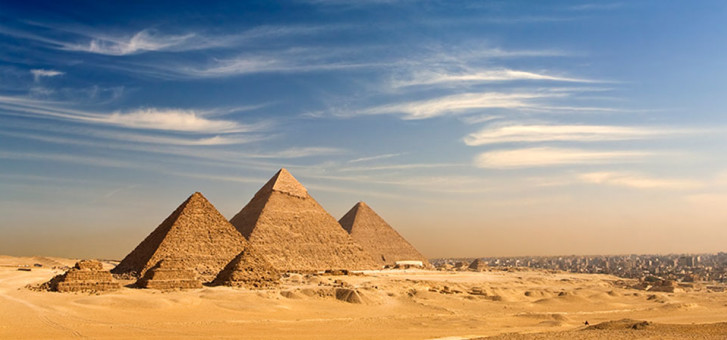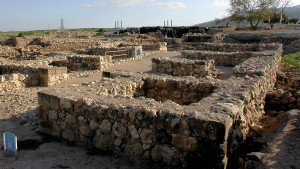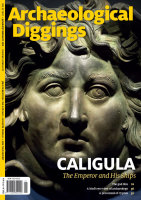Mummies receive CT scans
Missouri, USA
Medicine recently teamed up with the Saint Louis Art Museum and the university’s Mildred Lane Kemper Art Museum to scan some very unusual patients: three Egyptian mummies. The mum- mies, two of which are on long-term loan to the Saint Louis Art Museum from the Kemper Art Museum, were carefully transported across Forest Park and scanned one by one in a state-of-the-art computerised tomog- raphy (CT) scanner.
Among the early findings: One of the mummies already was known to have a brain, but scans revealed she also still has lungs. In many mummies, lungs typically were removed prior
to burial. The scientists—radiologists with the university’s Mallinckrodt In- stitute of Radiology—discovered that the same mummy also has an array
of small objects around her head. It appears to be a headdress or embel- lished shroud, but other possibilities include packing material or debris.
The scientists were surprised to find that a second mummy appeared to be significantly shorter than his sarcophagus. Further scanning revealed that his head had been dis- lodged from his body, perhaps when grave robbers ransacked his tomb. They found an item on his chest that may have been a burial amulet missed by grave robbers. They hope to use the scanning data to reconstruct the item with a 3-D printer.
The mummies’ burial containers and wrappings identify each by name. The Saint Louis Art Museum’s mummy is Amen-Nestawy-Nakht, a male; the Kemper Art Museum mummies are Pet-Menekh, also a male, and Henut- Wedjebu, a female.
—Washington University, Saint Louis
4000-year-old CD-ROM decoded
Kozani, Greece
The Phaistos Disk was discovered in 1908 at the palace of Phaistos, in the northeastern part of the Aegean Island of Crete. The round clay object, tentatively dated close to 1700 b.c., displays an unknown language on both sides which is carved in a circular fashion, from outside to the centre.
The decoding of the disk has puzzled specialists for over a century, however new findings describe the disk as “the first Minoan CD-ROM” featuring a prayer to a mother. Gareth Owens, Erasmus coordinator at the Technological Educational Institute (TEI) of Crete, speaking at the TEI
of Western Macedonia, said the disk is dedicated to a “mother.”
“The most stable word and value is ‘mother,’ and in particular the mother goddess of the Minoan era,” said Dr Owens. He says there is one complex of signs found in three parts of one side of the disk spelling I-QE-KU-RJA, with I-QE meaning “great lady of importance” while a key word appears to be AKKA, or “pregnant mother,” accord- ing to the researcher. One side is devoted to a pregnant woman and the other to a woman giving birth.
—The Archaeology News Network
Animal sacrifice at Megiddo
Kozani, Greece
Who the gods worshipped at Tel Megiddo more than 5000 years ago remains unknown. But the ceremonies that took place at the vast Great Temple unearthed there clearly involved animal sacrifice. The evidence was found in two long, narrow corridors in the main structure of the impressive temple, which were full of bone refuse. So was a third corridor which served as an access path to them.
The archaeologists excavating the Great Temple—Dr Matthew J Adams, Prof David Ussishkin and Prof Israel Finkelstein—postulate that the corridors (favissae) served to ritually discard the bones after the animals’ sacrifice. We cannot know why they stored the bones, but it could have had to do with cultic belief in the sacred nature of the sacrificial refuse.
The bones themselves were examined by Dr Brian Heesse and Dr Paula Wapnish from Pennsylvania State University, who discovered that different locations along the corridors were used to store different debris from different stages of the animals’ carcass processing. Most of the remains found—more than 80 per cent—are of young sheep and goats. The rest were cattle.
The structured deposit of the remains “lend support to the sanctity of the process and suggest that there was a ritual dimension to the discard process,” suggest the researchers in an article published last April in The American Journal of Archaeology.
The temple was one of the largest structures in the Near East of its time (Early Bronze Age, 3300–2500 b.c.). The corridors with the bones were in its rear. The bones in the western corridor contained bones with cut marks, which probably came from early stages of carcass processing. The bones in the eastern corridor showed signs of burning, indicating they were “the remains from later stages of carcass processing and utilisation, i.e., discard from meals and burned detritus,” Hesse and Wapnish wrote.
Also, the western corridor contained lots of limb bones, while the eastern one had mainly head fragments but few limbs. This bolsters the hypothesis that each corridor was used as a deposit for sacral refuse resulting from different rituals or different stages of a ritual. That’s about all that can be said about the religious rituals at Megiddo at the Early Bronze Age, says Finkelstein. Precious little else is known about sacrificial activity in temples in ancient Israel and the Levant at that time period.
It would be reasonable to assume that animals were sacrificed at the temple from its construction until it was abandoned about a hundred years later, but that cannot be proved. Archaeologists are divided on why the temple, in which so much had been invested, was abandoned: some think there is evidence for a “killer earthquake” that hit Megiddo, which is located on the Carmel fault, but others reject that theory.
The temple was discovered in 2010 by the Tel Aviv University Megiddo Expedition, which has been working at the tel since 1992. Although the temple at Tel Megiddo is the biggest of its time—at least found so far—it isn’t the only example of construction on a vast scale to be found in ancient Israel.
—Ran Shapira, Haaretz
Rare exhibition coup for university museum
Michigan, USA
In a few months, the Siegfried Horn Museum at Andrews University in Berrien Springs, Michigan, will exhibit 48 ancient fragments of possibly religious ceramic figures depicting humans and horses. Dating from the eighth to sixth century b.c., they were excavated over more than a decade ago, ending in 2012 at Tall Jalul in Jordan.
While small, the exhibition, part of a one-year loan agreement with Jordan, will be something of a rarity. In re- cent decades, countries that house remains of the ancient world have become determined to keep archaeological finds within their borders. Partly as a result, many smaller archaeological museums at religious-affiliated schools across the United States, lacking the financial resources to buy works or borrow actively from other collections, are scrambling to increase the museums’ appeal.
For example, in 2005, a dig at Tel Zayit in Israel run by the Pittsburgh Theological Seminary unearthed a stone inscribed with the earliest known specimen of the Hebrew alphabet. While the stone attracted intense interest in the world of archaeology, it remains in Israel. Ron Tappy, professor of Bible and archaeology at the seminary and director of its Kelso Museum of Near Eastern Archaeology, said a year’s loan of the piece would be difficult because of costly insurance and liability issues.
“We are not in a position to buy collections of artifacts,” Dr Tappy said. To convey some of the excitement of the find, he said, “there is a small corner of the museum dedicated to the discovery at Tel Zayat.”
Even Andrews University, which is involved in two major digs, has a relatively small museum of six exhibition halls. While there are hopes to move the museum to a larger space, Constance E Gane, its curator, acknowl- edged that getting the funding is difficult and that the school, which had always supported the digs, now faces financial pressures.
—Geraldine Fabrikant, New York Times
Silent evidence of AD 363 Earthquake
Sea of Galilee, Israel
The skeleton of a woman with a dove-shaped pen- dant was discovered under the tiles of a collapsed roof by archeologists from the University of Haifa during the recent excavation season at Hippos-Sussita. They also found a large muscular marble leg and artillery ammunition from some 2000 years ago. “The data is finally beginning to form a clear historical-archaeological picture,” said Dr Michael Eisenberg, head of the interna- tional excavation team.
The city of Hippos-Sussita, which was founded in the second century b.c., experienced two strong and well-documented earthquakes. The first was in the year a.d. 363 and it caused heavy damage. The city did, how- ever, recover. The great earthquake of a.d. 749 destroyed the city, which was subsequently abandoned completely. Evidence of the extensive damage caused by the earth- quake of 363 was found in earlier seasons. None, however, was as violent, thrilling and eerie as the evidence discov- ered this year.
To the north of the basilica, the largest building in town that served as the commercial, economic and judicial centre of the city, the dig’s senior area supervisor Haim Shkolnik and his team unearthed the remains of several skeletons that had been crushed by the weight of the collapsed roof. Among the bones of one of the women lay a gold dove-shaped pendant.
This year, evidence was found for the first time that the great earthquake of a.d. 363 had destroyed the Roman bathhouse, which was uncovered by the team run by Ar- leta Kowalewska from Poland. Like the basilica, it too was not rebuilt. According to Eisenberg, the evidence found so far shows that the earthquake was so powerful it com- pletely destroyed the city, which took some 20 years to be rebuilt. Among the wreckage from the bathhouse, an excellent Roman marble sculpture of a muscular right leg of a man leaning against a tree trunk was found. “It is too early to determine who the man depicted in the sculpture was. It could be the sculpture of a god or an athlete; it was more than two metres [six feet] tall. We hope to find more parts of the sculpture in the coming seasons to shed some light on his identity,” said Eisenberg.
—University of Haifa
Pharaonic temple under Egypt house
Al-Badrashin, Egypt
A group of men discovered a 3400-year-old pharaonic temple from the reign of warrior king Thutmose III (picturered is his basalt statue in the Luxor Museum) under their house in a city south of Cairo. Antiquities Minister Mamdouh al-Damaty said the seven men made the find during an illegal excavation in Al-Badrashin, 40 kilometres (25 miles) from the capital. Themen, using diving equipment, had come across the temple in ground water after digging for nine metres (29 feet).
A team of experts from the ministry took over the excavation work, while the seven men were detained but later released because the area was not a heritage site. The monuments found include seven tablets, several column bases made of pink granite and a pink granite statue—remains of the temple from the time of Thutmose III, Damaty said. “We will start an excavation project in the area to find more,” he said.




